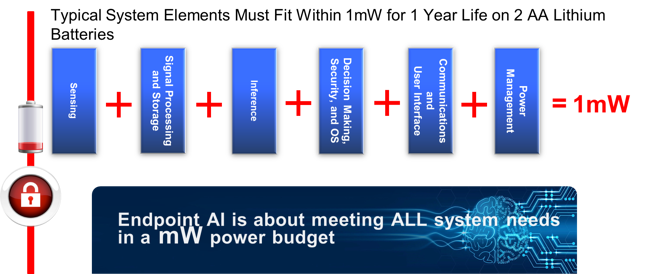In 1999, Neil Gershenfeld wrote in When Things Start to Think: “Beyond seeking to make computers ubiquitous, we should try to make them unobtrusive…. For all the coverage of the growth of the Internet and the World Wide Web, a far bigger change is coming as the number of things using the Net dwarf the number of people. The real promise of connecting computers is to free people, by embedding the means to solve problems in the things around us.”
Ten years later, Ambiq was founded with the mission to turn that unobtrusive, ubiquitous computing into a reality. Armed with the patented sub-threshold circuit technology, we have since revolutionized the power efficiency of edge devices to help realize the vision of the Internet of Things (IoT), one device at a time. Over 75 million units were sold to empower devices worldwide in the last ten years.
Today, the number of devices already far exceeds the global population. According to Intel, there are 26 connected objects for every human being on Earth in 2020. However, as you will quickly realize, our present is not as unobtrusive and ubiquitous as imagined. We may have a great many devices, but they aren’t truly connected. The advance of smartphones propels our lives by leaps and bounds, yet we are still tethered to products by different circumstances. Why?
One word—power.
More specifically, power by battery, disposable and rechargeable.
IoT will continue to stay as a pleasant dream unless all devices, especially personal and battery-powered ones growing at a breathtaking pace, are connected and communicating as intended. However, some manufacturers have already made IoT possible now by enabling their devices to last days, weeks, or even years on end without battery recharging or replacement.
From fitness trackers to smartwatches to smartcards and security units, Ambiq has brought its extreme ultra-low-power technology to some of the world’s biggest brands. At the heart of Ambiq’s ultra-low-power technology is the Sub-threshold Power Optimized Technology (SPOT™) Platform. Simply put, SPOT enables semiconductor products to operate at ultra-low voltage levels inside the processor chip. Since energy scales as voltage squared, this dramatically increases power efficiency and battery life of the devices.
With SPOT, Ambiq has been able to help electronic manufacturers extend battery life and add new features including Always-On-Voice in small form factor, battery-powered products, such as smartwatches, smartcards, and IoT sensors. Our embedded solutions have lowered power consumption by a factor of ten, enabling use cases that change the way we live in ways that we didn’t anticipate.
In this post, we’ll reflect on our 10-year journey and share with you ten valuable insights we’ve learned along the way.
INSIGHT 1: Many new possibilities become available when you can improve on power by a factor of ten.
Ambiq was born on the premise of ultra-low power. Still, we’ve managed to further lower the power consumption by a factor of ten in ten years to enable all kinds of new applications. We first beat everyone by 5-10X and then we improved on our own records by another 10X. Technologies that once seemed far fetched, such as always-on earbuds or contactless biometric payment solutions, are already here or are on the way.

Our technology began as real-time clocks and simple circuits. Over time, these solutions evolved, converged, and catalyzed into the now always-on edge processing. Edge processing enables edge devices like a smart band or a smartwatch to handle increasingly complex computation directly on the device without sending processes to the cloud.
INSIGHT 2: Embedded solutions are enabling new applications and new use cases.
The highly complex processors found in today’s smart devices are far superior in both computing power and power consumption. These embedded solutions are enabling greater processing capabilities, which make new use applications and use cases possible. These new use cases have revolutionized the ultra-low-power marketplace and the world. Whether shopping, traveling, or at work, ultra-low power Edge AI enables connected yet contactless interactions.
The traditional CPUs or GPUs are no longer dominating the consumer device landscape. As the industry competes to create more devices to realize the IoT vision, multi-faceted microprocessors and microcontrollers are becoming the darlings for solving the performance vs. power consumption requirements within a very constrained footprint.
INSIGHT 3: The whole (vision of IoT) is more than about the sum of its parts.
To carry out Neil Gershenfeld’s vision, all things should be connected. If we need to charge our phone and watch every night, rely on electricity for smart speakers and surveillance cameras to work, and tether to cables and cords for devices to operate, we will never be able to avoid “interruption.” Making devices last for longer to stay connected is the key to the reality of IoT.
INSIGHT 4: Edge Devices will play an increasingly larger role to connect us.
The coronavirus is intensifying the focus on the role of edge devices in this changing environment. With quarantines and stringent safety and security measures in place, global leaders are balancing the need for saving lives while avoiding economic collapse. According to NY Times, South China Morning Post, and NBC10 Boston, countries and governments are looking into using fitness bands to help track and detect Covid-19. Staying connected, either with family, friends, caregivers, or society at large, is upmost critical and essential to our well-being in this time of crisis.

INSIGHT 5: Edge devices needs to be artificially intelligent to interact with each other without human instructions.
To connect is to facilitate communication smoothly and automatically. For edge devices to interact with each other without human instructions, they need to be intelligent—artificially intelligent. Running machine learning (ML) in the cloud where there is an unlimited amount of computing power is a luxury that edge devices can’t afford. Product and system engineers must consider the power consumption and battery utilization while deciding how much processing and memory resources to dedicate to AI.
INSIGHT 6: Edge AI has many hurdles to overcome to be commercially proliferated.
Edge devices have strict requirements that have prevented their ability to run inference models and mimic human intelligence. They need to be real-time, always-on, portable, mobile, compact, secured, and, most importantly, battery-powered. All these requirements need to be packed into a self-constrained, system solution that includes sensing, data storage, analysis, inference, and communication in a 1mW power budget. While there are plenty of companies that have AI devices for the cloud and edge, no company has been able to solve the problem of packing AI into the constraints of edge devices. Until Ambiq’s SPOT technology came along.
INSIGHT 7: When it comes to total power budgets, TOPS/W is not relevant in a battery-powered application limited to an mW.
Today’s AI companies talk about TOPS/W with total power budgets of Watts or Kilowatts. However, TOPS/W is not even relevant in a battery-powered application that’s limited to an mW. Most of today’s AI system solutions will burn more than 1mW while just being asleep. Even the most power-efficient alternative embedded solutions today or purpose-built inference accelerators can only run a simple inference model for < 1mW. When adding in the rest of the system requirements, they break the power budget.

INSIGHT 8: Moore’s Law is alive and well for the ultra-low power, deeply embedded world.
Though it originated over half a century ago, Moore’s Law, which essentially states the number of transistors on a microchip doubles about every eighteen months, is alive and well for the ultra-low power, deeply embedded world. In particular, Ambiq is migrating two generations of semiconductors from 40 nm to 22 nm, which will take full advantage of Moore’s Law and our unique circuit design and architecture. On the other hand, Intel data center processors and the bit app processors in cell phones are at a 7 nm semiconductor process node, meaning they are nearly at a point where they can shrink no further, which means Moore’s law is running out of steam there.
INSIGHT 9: As smart devices become more personalized, the level of privacy and security will increase.
When it comes to their smart devices, people are rightfully concerned about privacy and information security. However, as these devices become more personalized, the level of privacy and security will increase. The more processing that a device can do locally, the less will be transmitted to the Internet. While there is already some security on your watch, earbud, or key fob, hearing aids, we have barely scratched the surface on the application of Edge AI to keeping personal what you want to keep personal.
According to Forbes, IoT technologies such as smart fitness trackers and smartwatches are among the favorites of tech experts. As it turns out, Ambiq has been paving the way in these industries. When it comes to smart fitness trackers, we’re working with 8 of the top 10 leading manufacturers, including Citizen, Fossil, Huawei, and Xiaomi. For smartwatches, we helped extend Huawei’s devices’ battery life from one day to two weeks. Oppo launched their first smartwatch series back in March 2020, which is promising up to 21 days on a charge in power saver mode.
The potential applications of Ambiq’s SPOT platform are only beginning to be implemented by more manufacturers who see the battery life being a key market differentiator for their products. Soon, there may be a wireless personal assistant button that is the size of a quarter while having the same capabilities as a smart speaker like an Amazon Echo.
INSIGHT 10: IoT devices will become more intelligent and more personal as Edge AI technology becomes more sophisticated.
As AI technology becomes more sophisticated, edge devices will be expected to do more and run longer. This may result in an evolution in how we use devices like smart fitness trackers and wearables. If you rarely have to remove your smartwatch for charging, it is a different experience that will further enable the lifestyle where you have small, portable, personal devices embedded in and around you to make your life better and safer.
Ten years and 75 million devices powered later, we’ve come a long way from just a startup with a big idea. We are fortunate to have our existing customers as early adopters to help us grow. As we proceed into our second decade as the leader of the ultra-low-power revolution, we hope you’ll join us in our pursuit to improve and enable edge intelligence and make the IoT dream into a reality.


